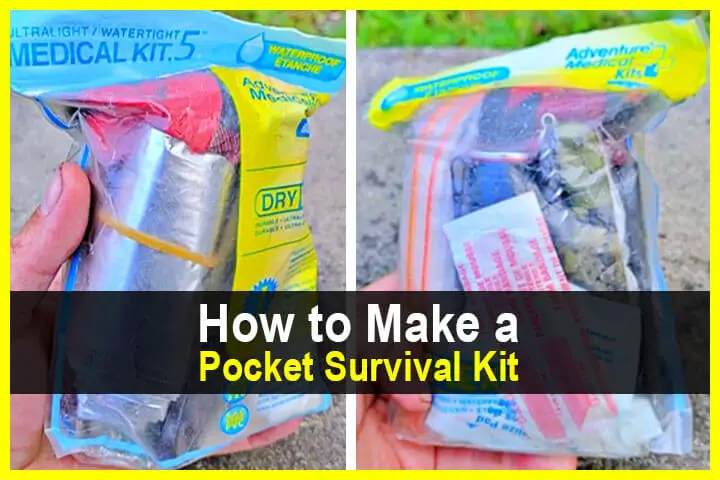Estimated reading time: 11 minutes
Navigating through the wilderness without any kind of survival kit is a daunting challenge that could turn fatal quickly.
A pocket-sized survival kit can be a lifesaver, providing essential items like a first-aid kit, a multi-tool, a fire starter, and a compass, all compact enough to fit in your pocket, ensuring you have the means to address immediate dangers and increase your chances of survival in a wilderness setting.
This article serves as your survival manual, exploring the essential items for your compact lifeline and their essential uses. By the end, you’ll know how to turn a handful of items into a lifeline, potentially saving your life or someone else’s in a dire situation.
Want to save this post for later? Click Here to Pin It On Pinterest!
Personalizing Your Survival Kits for Different Climates
Every individual’s survival kit may differ slightly based on personal needs, the type of outdoor activities they engage in, and the specific climate they will be venturing into.

For instance, when preparing for extreme climates, it’s advisable to have two different survival kits: a warm climate kit and a cold climate kit. Both kits will share some common essential items like a first-aid kit, a fire starter, and a compass.
However, a warm climate kit might incorporate sunblock and hydration salt, whereas a cold climate kit would include items like emergency blankets and hand warmers.
Selecting the Right Container
The container holding your survival kit items is as crucial as the items themselves. A durable, waterproof container such as a small dry bag is an excellent choice. It’s compact enough to fit inside a cargo pants pocket without being cumbersome. This way, your essentials are protected from the elements and always within arm’s reach.

Organizing Your Survival Kit Items into Groups
Grouping your survival kit items can enhance your packing efficiency and usability in crises. Here’s how to make it work:
H2O Heroes: The Water Group
Water is the lifeblood of survival. It hydrates the body, regulates temperature, aids in digestion, and is essential for many other vital processes. In an emergency, a reliable source of clean water is paramount.
1. Water Purification Tablets: Compact and easy to carry, these tablets can make questionable water safe to drink. They neutralize bacteria, viruses, and other microorganisms, making them an essential component of any survival kit. Apart from drinking, the purified water can be used for bathing wounds or cooking.
2. Collapsible Water Container: This lightweight and portable item is made of flexible rubber and can hold a significant volume of water. The advantage is that it can fold down thin and slipped into your survival kit.

3. A Clean Bandana: Not only does a bandana act as a cloth filter to get rid of debris in your drinking water, but they can also fold up nice and small so that they can fit into the small container you’re using.
While these items can ensure you have access to safe, drinkable water, remember that water purification tablets do not remove dirt or debris. Therefore, whenever possible, opt for the cleanest water source available.
Ignite the Night: The Fire Group

Much like water, fire is a cornerstone of survival, providing heat, light, signal, and a means to cook food and purify water. Luckily, a lot of materials that can be used to help build a fire are compact and will easily fit into your kit. Here are the items you should include in your survival kit:
Waterproof Matches: Waterproof matches are a staple for any survival scenario. They’re coated with a special substance that allows them to remain lit even when exposed to water or dampness. In a survival situation, this ensures you can start a fire regardless of the weather conditions.
Cotton Balls and Vaseline: Among the most underrated yet effective fire starters are cotton balls smeared with Vaseline. The cotton acts as a wick, while the Vaseline – or petroleum jelly – serves as fuel. This combination can ignite easily and burn steadily, providing a reliable fire source for several minutes.
Ferro Rod: A ferrocerium rod, commonly known as a ferro rod, is another critical fire-starting tool. When struck with a hard object, it produces hot sparks capable of igniting your prepared tinder. It’s a highly durable and long-lasting tool that works even in the coldest, wettest conditions.
A Small Folding Knife and Saw: The knife can be used to whittle down branches, create kindling, or cut small pieces of wood, while the folding saw can handle larger branches that are difficult to break by hand. These compact tools not only ease the process of preparing your firewood but also ensure you maintain a sustainable fire over an extended period.
In addition to the items mentioned above, don’t forget that nature itself provides an array of resources that can assist in fire building. For instance, birch bark, even when damp, contains oils that enable it to catch fire and burn steadily.

Lifelines in a Kit: The Medical Group
Just as vital as fire starters in your survival kit are your medical supplies. Having the ability to address basic health needs in the wilderness can be the difference between life and death. A well-equipped medical group in your survival kit can cover a broad spectrum of common injuries and ailments you may encounter in the wild.
This includes, but is not limited to, cuts, sprains, insect bites, and burn injuries. Let’s explore the essential items you should consider including in your survival kit to enhance safety and well-being during your outdoor adventures.

Bandages: Bandages are essential in any survival situation. They’re used to cover wounds, preventing dirt and bacteria from entering and causing infection. They also help stop bleeding and start the healing process.
Antiseptic Wipes: When in survival mode, cleanliness is crucial to prevent infections, and antiseptic wipes are an absolute necessity. They’re used for cleaning wounds before bandaging, reducing the risk of infection and speeding up the healing process.

Multipurpose Ointment: A multipurpose ointment can serve various functions, from treating cuts, scrapes, and burns to relieving skin irritations. Having a good quality multipurpose ointment in your kit can go a long way in alleviating discomfort and promoting healing.
Needle and Thread: A needle and thread can be lifesaving when medical help is inaccessible. They’re used for suturing deep cuts or wounds that bandages alone cannot manage. The thread closes the wound, keeping it clean and promoting faster healing.
Painkillers: Painkillers provide temporary relief from pain and can be essential in survival situations. They can reduce discomfort and inflammation, allowing you to keep moving and stay focused on survival.
Shelter from the Storm: The Shelter Group
Exposure to harsh weather conditions can lead to hypothermia, dehydration, or heatstroke, which are serious threats in survival scenarios. A good shelter can protect you from the elements as well as wild animals and insects, creating a safe space for rest and recovery.

Mylar emergency blankets: These are highly versatile and lightweight blankets for crafting a quick shelter. Its reflective surface helps retain body heat and can double as a signal for rescuers. Simply tie the blanket between two trees or use it to line the inside of a makeshift structure for added warmth.

Paracord: It’s an invaluable resource when constructing a shelter. Its durability and versatility make it ideal for securing structures, stringing up tarps, or even crafting a fishing line or a snare trap using the inner strands. The best variety is the 550, 7-strand paracord which can be purchased readily online and in stores.
You can also use the resources nature provides to build a debris shelter. Collect branches, leaves, and other foliage to construct a rudimentary shelter that will shield you from the elements. It may not be a five-star hotel, but in survival situations, it could very well save your life.
Finding Your Way: The Navigation Group

In survival situations, even the keenest memory or the most distinctive landmarks can sometimes fail you. Exhaustion, disorientation, or inclement weather can all hinder your usual sense of direction.
It is in these challenging moments that certain tools become critical in guiding you back to civilization. These items are designed to aid your orientation and keep you moving in the right direction, no matter how harsh the conditions may be.
Small Button Compass: This simplistic yet effective tool is an essential item to help you find your bearings in a survival situation. A compass provides a reliable way to establish cardinal directions and navigate through unfamiliar terrain. Also remember the saying, ‘Never Eat Soggy Wheat’ (North, East, South, West).
Signaling Mirror: A signaling mirror becomes handy when you need to attract attention from afar, especially during the day. Its reflective surface can create a light signal visible from several miles away, a potential lifesaver when you’re trying to catch the eye of search and rescue teams.

Headlamp/ Pocket Flashlight: Illumination is critical when you’re navigating in low-light or night conditions. A headlamp or flashlight not only helps you see where you’re going, but it can also function as a signaling device. Choose a model that’s durable, waterproof, and has an extended battery life.
Wandering around in the wilderness without these items is like going on a blind date. You have no idea where you’re going, and there’s a good chance you’ll end up lost, cold, and alone… but at least in the wilderness, there won’t be any awkward small talk.

Preparedness Lights The Way
This small kit is full of inexpensive items that you can find at any local hardware or discount store. Keep the kit handy in your vehicle or backpack for emergencies.
Additionally, purposely venturing into the wilderness without the proper tools is like trying to assemble a puzzle blindfolded – it’s possible, but infinitely harder. Arm yourself with a compass, knife, and flashlight, and you transform from a hapless wanderer into an equipped explorer.
Like this post? Don’t Forget to Pin It On Pinterest!


















